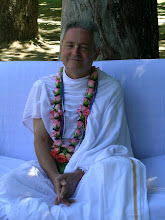Part II
Every religious tradition, if authentically lived, conveys a universal vision because it teaches, even though in different fashions and manners, that nothing is separated from the rest, that each part is connected to the whole and that the whole is connected to each part. The term “religion” comes from the Latin "religere" which means ‘gather, unite’, the same as the word yoga derives from the Sanskrit root yuj having the same meaning: ‘connect, unite’. Without Yoga, without the reconnection between the individual consciousness to the cosmic Consciousness, peace cannot be sustained because we can realize it only when the person has acquired a deep awareness of the marvellous subtle network we are part of, when we perceive the common Source that all is connected to the whole and that our well-being implies the well-being of the others. Love for God is the highest warrant of peace because loving God means to love all living beings too, by considering the common origin and the indissoluble reunion with Him. One of the fundamental texts of Indovedic spirituality, Bhagavad-gita (V.29) explains that peace is reached by those who, through the recognition of God as the beneficiary of all sacrifices and of all austerities and the Supreme friend of all human beings, offer their service and their pure devotion to Him. The essence of Bhagavad-gita is bhakti or love for God that includes love for the world and all the creatures, as expansions (and Epiphany) of the Absolute. In this tradition the value of ahimsa or “non-violence” is not intended solely in the respect of human beings, rather in the respect of all living creatures because compassion, solidarity and mercy cannot be and must not be reserved to a sole race or a biological specie. The path that leads to peace follows inevitably the way of consciousness, because its vision is not seen apart from a universal vision, indeed it is aware that there are indissoluble ties that unite mankind to wholeness. The progressive understanding of this union and a conduct coherent to it, contribute to the diffusion of the harmony among all creatures. This exercise of comprehension should be developed in the respect and appreciation of every authentic path, on the laic and religious levels, with the awareness that there are different modes and multiple ways to approach progressively the holy Reality that is the essence of all that exists, in all its infinite manifestations, that is revealed as the Divine as supreme source of life, superior principle of harmonization, unity and peace.
Every religious tradition, if authentically lived, conveys a universal vision because it teaches, even though in different fashions and manners, that nothing is separated from the rest, that each part is connected to the whole and that the whole is connected to each part. The term “religion” comes from the Latin "religere" which means ‘gather, unite’, the same as the word yoga derives from the Sanskrit root yuj having the same meaning: ‘connect, unite’. Without Yoga, without the reconnection between the individual consciousness to the cosmic Consciousness, peace cannot be sustained because we can realize it only when the person has acquired a deep awareness of the marvellous subtle network we are part of, when we perceive the common Source that all is connected to the whole and that our well-being implies the well-being of the others. Love for God is the highest warrant of peace because loving God means to love all living beings too, by considering the common origin and the indissoluble reunion with Him. One of the fundamental texts of Indovedic spirituality, Bhagavad-gita (V.29) explains that peace is reached by those who, through the recognition of God as the beneficiary of all sacrifices and of all austerities and the Supreme friend of all human beings, offer their service and their pure devotion to Him. The essence of Bhagavad-gita is bhakti or love for God that includes love for the world and all the creatures, as expansions (and Epiphany) of the Absolute. In this tradition the value of ahimsa or “non-violence” is not intended solely in the respect of human beings, rather in the respect of all living creatures because compassion, solidarity and mercy cannot be and must not be reserved to a sole race or a biological specie. The path that leads to peace follows inevitably the way of consciousness, because its vision is not seen apart from a universal vision, indeed it is aware that there are indissoluble ties that unite mankind to wholeness. The progressive understanding of this union and a conduct coherent to it, contribute to the diffusion of the harmony among all creatures. This exercise of comprehension should be developed in the respect and appreciation of every authentic path, on the laic and religious levels, with the awareness that there are different modes and multiple ways to approach progressively the holy Reality that is the essence of all that exists, in all its infinite manifestations, that is revealed as the Divine as supreme source of life, superior principle of harmonization, unity and peace.






